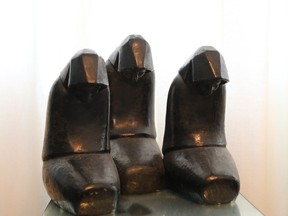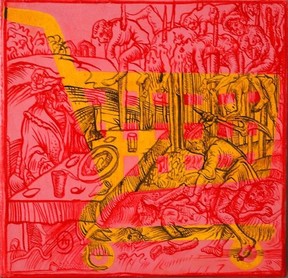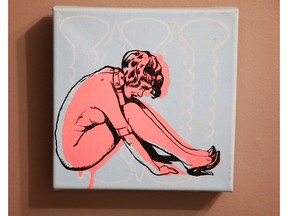A longtime supporter of the local arts scene, Bill Staubi was diagnosed with Stage-4 liver cancer last fall. Now he’s giving away more than 1,200 pieces.

Reviews and recommendations are unbiased and products are independently selected. Postmedia may earn an affiliate commission from purchases made through links on this page.
Article content
It was little more than happenstance that led Bill Staubi to purchase his first work of art.
He was a 24-year-old BA grad student living in Saint John, N.B. in 1978, and a handful of artists were hanging a group show in the large living room of the residence where he lived. They needed help with the grunt work, and Staubi, having nothing better to do, volunteered.
Article content
By the end of the day, he’d become so captivated by the artwork that he bought five pieces — one from each artist.
Advertisement 2
Story continues below
Article content
He had absolutely no money, though, so he went to the bank that held his student loan, and negotiated another loan, for $360, to purchase the pieces. “The manager was amazed that I wasn’t buying a car or stereo or going on a crazy vacation, so he took a chance,” Staubi recalls. “I should have realized then that that was a glimpse into my future.”
Today, the walls of Staubi’s downtown, two-bedroom apartment are almost completely covered in art — hundreds of pieces that he’s collected over the past 46 years, representing just about every medium possible. Most are figurative or representational; abstract art isn’t his jam. Queer and religious themes are noticeable, but it would be unfair to buttonhole his collection by either of those descriptors — there’s simply so much of everything.
And like a well-stocked museum, the pieces on the walls, shelves, windows and floors are just the tip of the iceberg; his collection numbers between 1,200 and 1,300 pieces, most by Ottawa artists and most purchased when those artists’ careers were just beginning and they most needed support.
Article content
Advertisement 3
Story continues below
Article content
When he looks at art that captivates him, Staubi feels it, viscerally, in his chest and his head. “Sometimes it’s almost a desire to grab it right there,” he explains, “or I’m haunted by it if I walk away.” The feeling, he adds, may soften over the years, but it never goes away.
So one can only imagine what he’s feeling now, as he looks at these treasured pieces for the last time.

Last fall, Staubi, 69, was diagnosed with Stage-4 liver cancer. His prognosis suggests he’ll make it to 70, but no further. Rather than saddle his son with the onerous chore of dispersing the collection, Staubi is doing it himself while he’s still well enough.
Some of the pieces will find their way back to the artists who made them. Some will go out the door as gifts to friends. Most will be gifted elsewhere, finding new homes in galleries where members of the public might feel the same sort of palpitations that Staubi felt when he first saw them. About 125 are going to the City of Ottawa’s collection, and another 50 to the Ottawa Art Gallery’s. Twenty-one will go to the Thunder Bay Art Gallery. One piece, depicting the 1971 riot at the Kingston Penitentiary, will likely make its way to the Penitentiary Museum in that city.
Advertisement 4
Story continues below
Article content
“I always knew that when my time came, the collection would have to go,” he says. “I’m glad that so much of it will go to places that can store and properly take care of it, and where people will get to see it.”
Still other works are being donated to organizations — the Ottawa Arts Council and the Mississippi Textile Museum, to name a couple — for fundraising purposes.
I first met Bill two years ago while interviewing members of Ottawa’s queer community for a Pride Month feature for the paper. Unrelated, I was working on a photo exhibition of my own at the time — my first — and upon learning of his connection to the art world, I began picking his brain for advice. Bill is himself an artist who serves on art juries and in an advisory capacity, and his support of local artists goes far beyond simply purchasing their work.
As someone who had difficulty considering myself an artist, I cannot overstate how Bill’s encouragement put me at ease. I sent him an invitation to my show, though I didn’t really expect to see him. But not only did he come to the opening, he was the first to buy a piece. So I well understand how, were I a young artist hoping to walk that path in any kind of professional manner, his support, either through an early sale or simply some sage counsel, could make all the difference.
Advertisement 5
Story continues below
Article content
“Artists face a lot of rejection, a lot of criticism,” he says. “One of the great rewards for me is seeing the moment when an artist goes, ‘Oh, my god, this might be for me, this might have been the right choice.’”
Indeed, Ottawa’s arts scene has been immensely fortunate to count Staubi among its advocates, and there’s going to be a large hole in it when he’s no longer with us. But if one of his chief legacies has been the support of local artists, I hope another will be to encourage others to do the same.
“I’ve always wanted to live in a place that had a vibrant arts community,” he says, “that had things to go to and things to see that would make me question what I thought, and this is one way to do that.
“You have to make the world you want,” he adds. “I can’t cure hunger. I can’t stop what’s happening in the Middle East. I can’t solve inflation. But I can make someone feel good about the career choice they made, and by sharing what I’ve done with this collection I might inspire others. Maybe not on this scale; I accept that I’m eccentric. But if you want to live in a place where local artists can work and thrive, then support them.”
PHOTO GALLERY OF BILL STAUBI’S ART COLLECTION





















Born in Fort William, Ont., a city that no longer appears on maps, Bruce Deachman has called Ottawa home for most of his life. As a columnist and reporter with the Citizen, he works at keeping Ottawa on the map. You can reach him at bdeachman@postmedia.com.
Recommended from Editorial
Article content


Comments